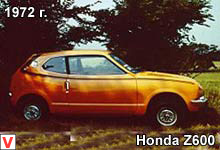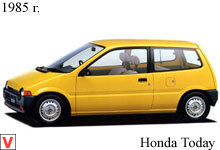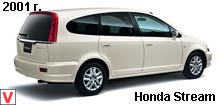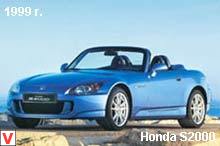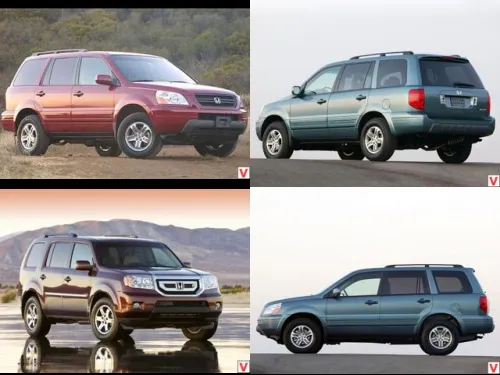
The full-size Honda Pilot SUV made its 2001 debut. Created on the same platform as the SUV Acura MDX that debuted a year earlier, it was the largest off-road vehicle in the entire history of the brand. The car was developed by the American branch of the Japanese company, initially it was intended only for the overseas market. But it turned out so successful that Honda dealers gradually began to sell it in other markets. The interior is rather conservative.
Landing comfortable, reclining, almost like a passenger car. Coasters are available in unlimited quantities, as well as various "glove compartments" and pockets for storing luggage. On the back of the sofa has a special pocket for storing electronic games, markers, albums and other children's small things. The manufacturer positions the Pilot as the only eight-seat car in its class. In fairness it should be noted that it is possible to consider this eight-seat machine only nominally. Sitting together on the back of the couch uncomfortable. It is noteworthy that in just a few seconds the third row can be folded up as if it had never existed.
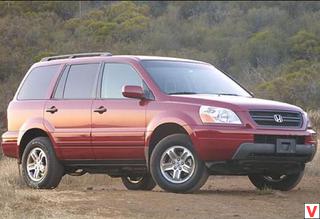
He is completely unnoticed hiding under the floor of an extensive trunk. If you add the second and third rows of seats, the volume of the cargo area will be 2.56 m³. When the second row is raised, the car can hold up to 1.38 m³. In the role of the main driving force impressive 3.5-liter V6 with 240 hp with the famous Honda's variable valve timing system VTEC. The engine, according to American tradition, is supplied exclusively with an "automatic", in this case 5-speed. The handle of its control, again in the transoceanic style, is located to the right of the steering column. Moreover, the suspension is also tuned in the American manner.
Pilot is addressed to those drivers who put comfort above all else and not speed. The chassis design resembles a business-class sedan (MacPherson struts are mounted in front, and the rear suspension is a very complex multi-link design). A large weight (more than two tons) does not allow this SUV to be graceful when cornering. As for the other abilities, all-wheel drive allows the car to cope with bad weather and not very serious ditches and potholes on the road. The Pilot has fully independent suspension on all wheels, disc brakes on all wheels and automatic all-wheel drive VTM-4. The car is deprived of the usual visco-clutch.
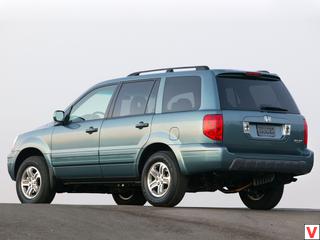
The process controls the electronics. Under normal driving conditions, the Honda Pilot is a conventional front wheel drive car, and it is on the front axle that the entire torque is transmitted from the engine. The rear axle is automatically connected only in the case of front slip: then the torque begins to “float” between the axles, determining which one has a higher coefficient of adhesion to the road surface. For heavier driving modes, there is a temporary blocking of the distribution of torque in the 50/50 ratio. The last function is activated by a button on the panel. By locking the clutch, it is possible to increase the throughput of the car, especially on viscous soils.
The VTM-4 system has several advantages over the traditional visco coupling. Firstly, it uses the 4x4 mode much faster. Secondly, off-road driver can use permanent four-wheel drive - when the engine all the time rotates all four wheels, regardless of whether the front stalled or not. In short, Pilot feels great off-road.
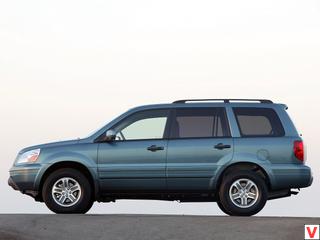
Confidence add short overhangs and a high landing body (ground clearance - 20.3 cm). In terms of passive safety, the Pilot cabin is equipped with an advanced level. Frontal airbags can be triggered by two algorithms: “easy” or “strongly”, depending on the severity of the collision. The side airbag for the front passenger is also "thinking." Special sensors evaluate the pose of a person in a chair, and the automation adjusts the opening of the air bag accordingly.
In the fall of 2004, production of upgraded versions of the Pilot began with an upgraded 3.5 liter V6 SOHC engine (244 hp, 309 Nm), a new 5-speed automatic transmission and an expanded bundle: air pressure monitoring system (TPMS) , VCA stabilization system, new audio systems, updated steering wheel design and a number of other changes. Available in two basic versions: LX and EX. As usual in Honda models, the primary equipment is quite rich. Standard items - air conditioning, cruise control, CD player. The EX model is equipped with alloy wheels, automatic climate control, a modern stereo system with a built-in steering wheel and a six-disc CD changer.
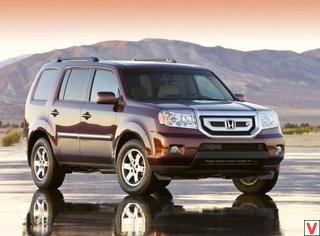
Standard EX with leather interior (EX-L) also includes satellite radio, a panoramic sunroof and heated seats; navigation system and DVD (options). In 2009, it was released the second generation of the SUV. The world premiere took place at the Detroit International Motor Show in January 2008. The European premiere of the SUV was timed to the Moscow Motor Show.
The project was developed in the design studio Honda in California, and production is established in the city of Lincoln, Alabama. Pilot 2009 looks more interesting than its predecessor. Changes affected the design, both appearance and interior. In general, the car began to look stricter. Salon Pilot 2009 is made in the same strict and unassuming style as the appearance. For passengers of the third row offers more space (added 2.5 cm wide and 7.5 long). Ground clearance is 20 cm (0.5 cm more than the previous model).
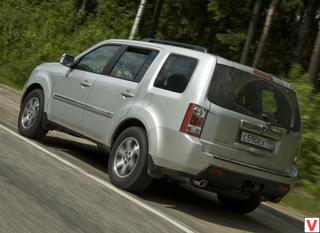
The 2009 Honda Pilot is offered in four trim levels: LX, EX, EX-L and Touring. Any of these versions is available with both full and front-wheel drive. The LX package includes seventeen-inch steel wheels, a built-in trailer hitch, power windows, a keyless door unlocking system, a telescopic steering wheel, adjustable in angle, full power, cruise control, separate 60/40 rows of the second and third rows and CD / MP3 audio system with seven speakers and an additional audio connector.
The EX version adds fog lights, seventeen-inch alloy wheels, an electrically adjustable driver's seat, a regular CD changer, audio control buttons located on the steering wheel, three-zone automatic climate control and satellite radio. The EX-L is distinguished by leather upholstery, heated front seats, a sunroof and a rearview camera built into the mirror. The top-of-the-line Touring model includes a ten-speaker audio system, a navigation system with voice recognition and a built-in backup camera, Bluetooth, a power tailgate, and a USB interface. Additionally, on the EX-L version, you can install a DVD multimedia system with ten speakers.
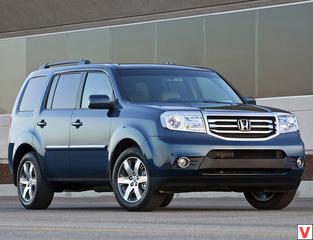
The DVD system is the only option available for the Touring, which initially comes with a ten-speaker stereo system. The 3.5-liter V6 engine received only minor changes. Engine power increased to 257 hp, and the torque value to 347 Nm. It is noteworthy that in the American market the power of this motor is 250 hp. The engine is paired with a five-speed automatic transmission. The car accelerates from zero to 100 km / h in 9.9 seconds. It was possible to slightly reduce fuel consumption, thanks to the non-working cylinder shutdown system (VCM), which automatically shuts off half of the V6 cylinders if they are not required.
By default, the Pilot is a front wheel drive car, but any model can be equipped with an all wheel drive system that automatically transfers the necessary power to the rear axle (up to 70 percent) when the front wheels slip. In addition, this system has a “lock” function, using which the driver can manually transfer up to 70 percent of the torque to the rear axle, provided that the speed is less than 30 km / h. Basic safety equipment includes disc brakes with anti-lock braking system, vehicle stability control, airbags for the front seats and a full-size inflatable curtain.
At the end of 2011, a restyled version of the Pilot was released, which differs from its predecessor in a renewed design of the front end and interior, with changes in equipment. The radiator grille now received horizontal stripes, the taillights became slightly different, the bumper and framing protivotumanok changed shape. Minor external changes have affected the size of the car - the length of the Honda Pilot has increased by 5 mm. Salon Honda Pilot created with all the modern requirements of the family car: comfort, a wide list of options, excellent ergonomics and spaciousness.
The “strict” center console catches the eye in the cabin (in the previous version it was cheerful turquoise) and a large color display (available only in the maximum configuration) with navigation and a rear-view camera. Thanks to these distinctive strokes, the car began to look more solid, stricter and even a bit more prestigious than the dorestayling version. The gasoline 6-cylinder 3.5 liter engine, as before, is equipped with the Variable Cylinder Management (VCM) system.
In the restyled version, the designers did even more work on efficiency - improved aerodynamics, introduced a set of measures to reduce friction of parts of the cylinder-piston group, including design changes and the use of oil with a low viscosity index (0W-20). This gave a noticeable result - the fuel consumption in the urban cycle decreased by 0.5 liters - to 15.8 liters per 100 km / h. By the way, the Eco indicator on the instrument panel helps to drive economically - it lights up when the engine is running in the “most gentle” mode.
